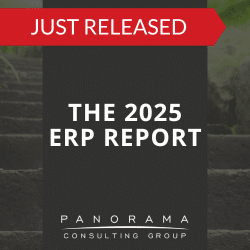If your company is considering a future merger or acquisition, having a robust ERP system already in place can position you for success. When an M&A opportunity arises, your existing ERP system can provide a foundation for a smoother integration process.
Today, we’re talking about one of the most overlooked reasons for implementing a modern ERP system: to put your company in a position to consider M&A activity.
The Benefits of ERP Systems During M&A Activity
Even if the existence of ERP systems at both entities ends up creating decision fatigue and integration challenges, it’s generally advantageous to have an ERP system in place. Here’s why:
1. Centralized Data Management and Smarter Decision-Making
Most ERP systems – whether you’re talking about niche ERP systems or the top ERP systems – have the ability to consolidate disparate data sources. With the right data management approach, organizations can leverage their ERP system to maintain data consistency and accuracy throughout the transition.
In addition, most ERP systems provide real-time data access, enabling stakeholders across the merged entity to make more informed decisions.
The 2025 ERP Report
72.6% of respondents said they've already deployed AI at their organizations. Learn about AI adoption and other ERP trends by downloading our latest report.
2. Streamlined Business Processes
The ability to streamline processes is a key benefit of ERP systems in the context of M&A. These systems can automate routine tasks and facilitate the adoption of best practices.
By adopting out-of-the-box best practices, organizations can standardize business processes across both entities, reducing complexity and redundancy.
3. Enhanced Communication and Collaboration
Communication silos are a common pain point for organizations that have recently completed a merger or acquisition. A unified platform is essential for enhancing collaboration across a newly integrated organization.
An ERP system can serve as such a platform by facilitating information sharing. With access to a single source of truth, employees can become more strategically aligned.
4. Cost Savings
When at least one company has an existing ERP solution, the M&A team can use it to replace the functionality of a variety of other systems, such as customer relationship management (CRM) systems, human resources (HR) systems, and supply chain management (SCM) systems. This consolidation reduces IT costs while streamlining processes and lowering operational expenses.
For example, excessive resources could be expended running both entities’ accounting systems in parallel, or resources could be optimized by choosing one system to process all financial data. The latter scenario would enhance resource allocation and help the organization avoid duplication and waste.
5. Better Risk Management
Mergers and acquisitions are inherently fraught with risk, but when at least one company has an ERP system, risk areas can be easier to identify. Providing enhanced visibility and control, ERP systems can enable comprehensive oversight and proactive risk management.
For instance, a manufacturing company might use an ERP system to ensure compliance with industry standards, such as health and safety regulations. This would minimize legal and financial risks, putting the company in a better position to consider M&A activity.
6. Reliable IT Infrastructure
Many ERP systems are scalable solutions that can grow with an organization, particularly through mergers and acquisitions. This scalability, combined with robust security features, makes ERP systems a reliable foundation for M&A.
Best Practices for Implementing ERP Systems
If you’re not embarking on a merger or acquisition any time soon, now might be the ideal time for implementing a new ERP system.
Here are the best practices our ERP software consultants follow when selecting and implementing enterprise software for clients.
1. Conducting a Thorough Needs Assessment
We take the time to understand the company’s current processes and document their business requirements. We also evaluate existing systems and infrastructure.
2. Involving Key Stakeholders from the Outset
From the leadership team to end-users, all stakeholders must understand the projected benefits of the ERP implementation. Many of these stakeholders should also engage in project decision-making and system selection.
3. Focusing on Continuous Communication and Training
While involving stakeholders is one way to gain project buy-in, providing ongoing updates is also essential. We always tell clients to keep end-users informed of timelines as well as changes to their roles and responsibilities. It’s also important to address feedback and concerns promptly.
System training is another important aspect of preparing employees for change, especially in scenarios involving strong change resistance.
Our change management consultants recently helped a retail company identify sources of change resistance before their ERP implementation proceeded. By creating customized ERP training materials and facilitating “train-the-trainer” sessions, we helped the company address the root causes of resistance.
ERP for M&A: What’s Your Next Move?
Centralized data management, streamlined processes, improved collaboration – these are some of the benefits of having an existing ERP system in place during a merger or acquisition.
Regardless of which company’s ERP becomes the system of record, existing ERP systems can be extremely helpful when preparing for M&A integration.
Could your ERP system be a powerful ally in a future merger or acquisition? To find out if it’s up to the task, contact our business software consultants below.













